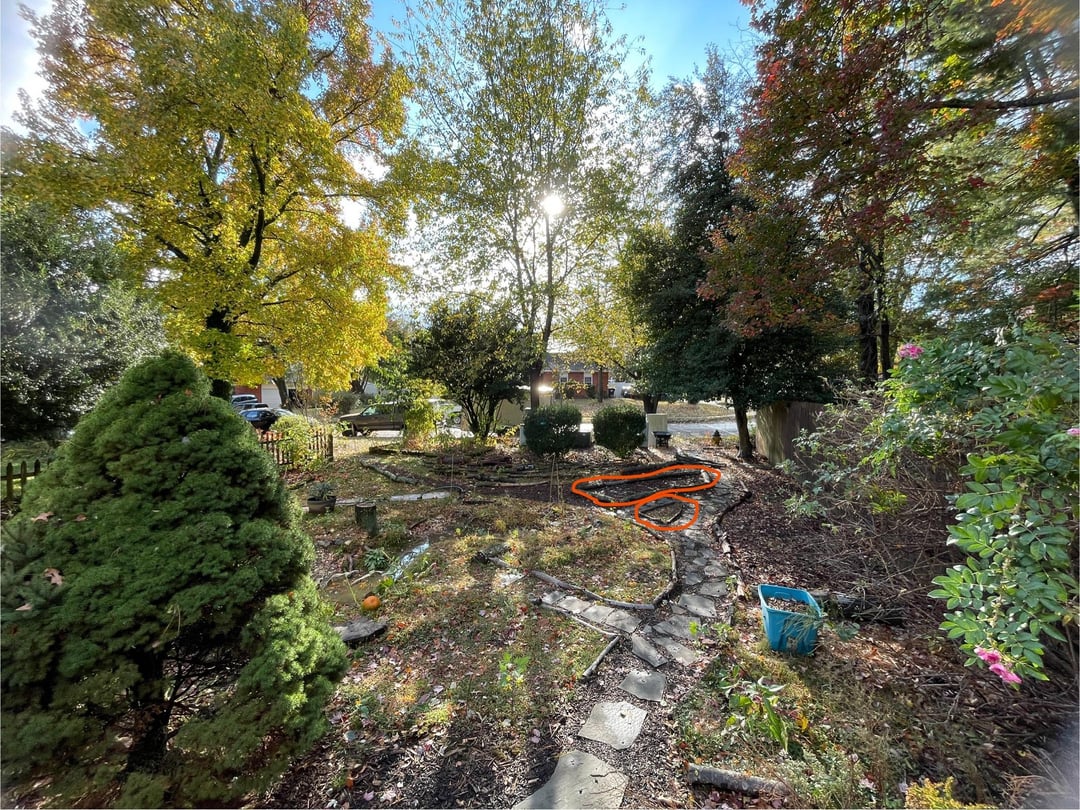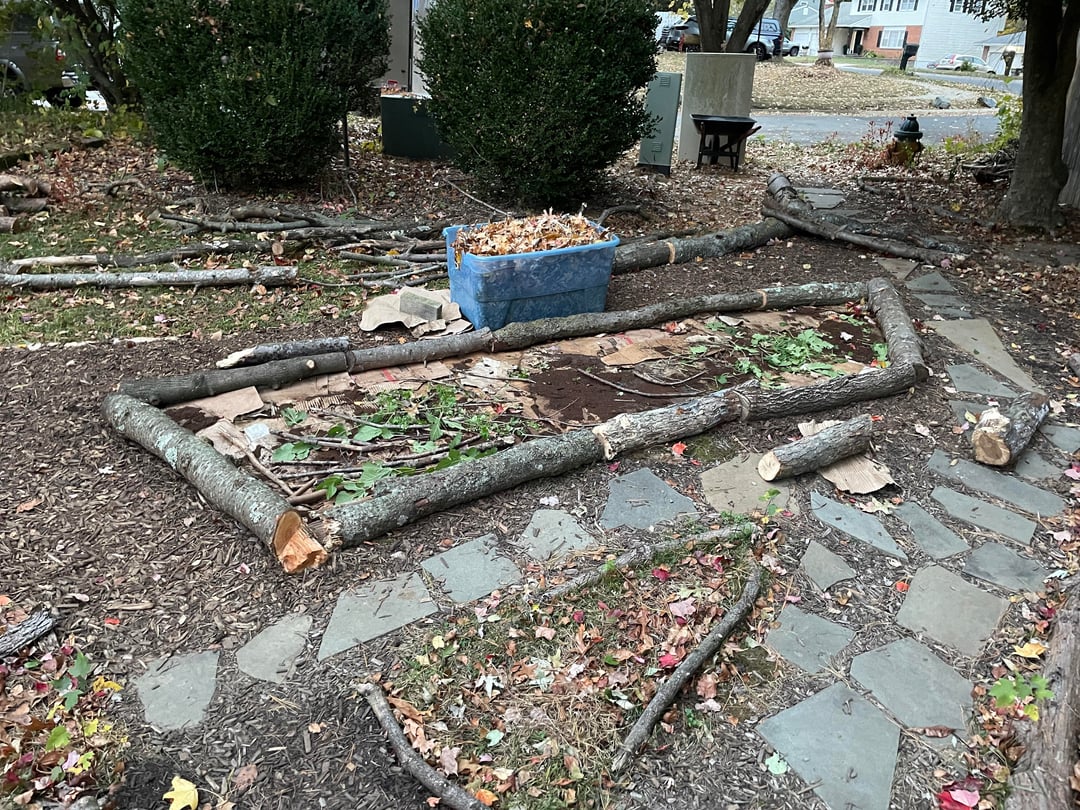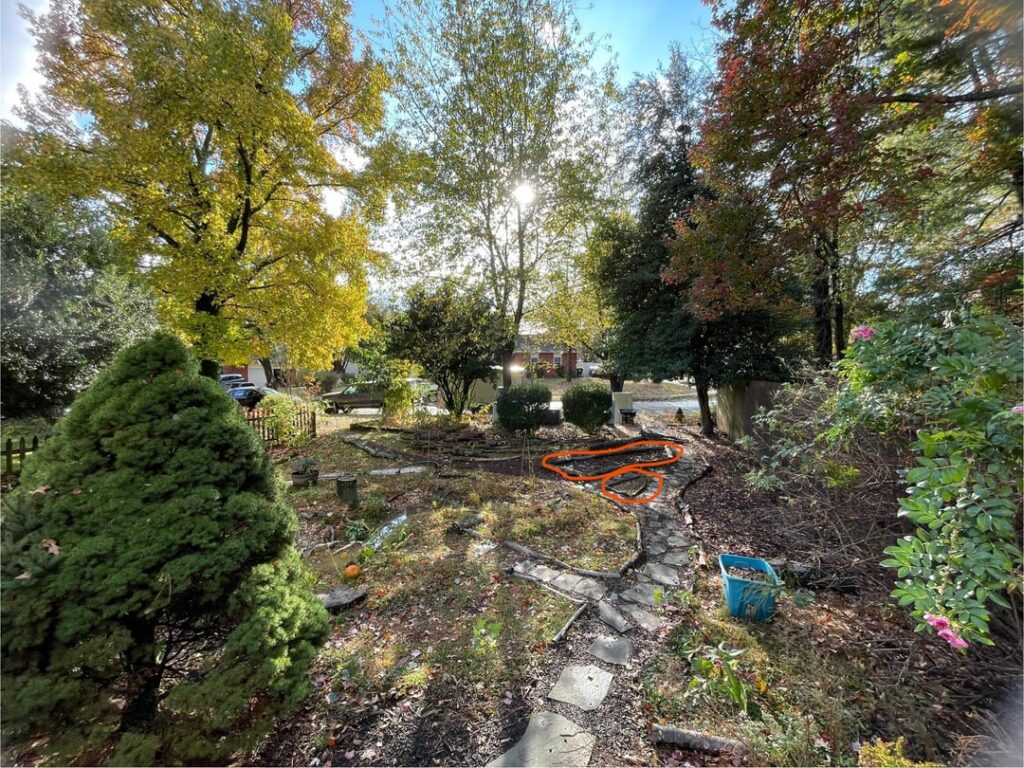



Converting this space that’s been 80% lawn into something ecologically valuable and not overrun by crabgrass, mock strawberry, and wintercreeper has been a very long and arduous process I’ve been working on nearly every single day for the past year. So it doesn’t look that great yet, but it was nearly entirely lawn & empty dry sandy clay garden beds one year ago so keep that in mind. I’ve been starting with a strong focus on soil rehabilitation via no mowing whatsoever, aggressive invasive removal, and continuously adding organic materials. I’m installing a path meant to feel like a woodland trail you’d find in a state park to minimize foot traffic and prevent further compaction. This is nowhere near done yet! That said…
What would you plant in these lasagna garden beds in process? They’re in the spaces between path segments. The soil underneath is pretty clay-ish and silty, minimal organic matter but I’m not sure how much that matters since I’ve begun the lasagna gardening process. The area gets a few hours of direct sun in winter and spring, less as the trees leaf out.
My ultimate vision for the space is to lean into the shady woodland feel towards the back end where the big trees are. A nice chestnut oak is popping up real fast back there as well as a few red maples and pawpaws. I’d like to fill all levels of vertical space much like you’d find in an old growth forest. Increasing moisture & topsoil retention on site are also goals, as well as maximizing biodiversity, fostering privacy, and breaking intense winds that blow up the street. I also need to make sure whatever goes there won’t become a massive obstacle while traversing the path.
General plants of interest for the goal aesthetic that matches my local ecology include but are not limited to:
-various ferns
-wild geraniums
-partridge pea
-mapleleaf viburnum
-northern spicebush
-witch hazel
-pawpaw
-great rhododendron (or similar natives)
-mountain laurel
-a singular eastern white pine
-a singular eastern red cedar
by leefvc


12 Comments
Pics 1 & 2 above are most recent, 3 & 4 are from earlier in the process.
For reference, here’s how it looked one year ago when all I had done so far was work to remove hundreds upon hundreds of feet of wintercreeper and that massive mature wintercreeper in the back behind the two boxwoods
https://preview.redd.it/ot7zf8osaiyf1.jpeg?width=1024&format=pjpg&auto=webp&s=b88a32e19c29fc6c3d9752fcc198139bd2153406
Mountain Laurel is a real showstopper but you’ll need to modify the soil to make it work. Definitely likes some acidity. In my opinion it’s worth it.
Have you considered Wine Cap mushrooms? They are easy to grow, delicious, and build soils quickly.
It sounds like it’s full to part shade? With those paths, I would want to keep it to shorter plants: heuchera, columbine, Virginia bluebells, woodland phlox, foamflower. Canada anemone, but it might takeover. Maybe blue wood aster. Sedges could make it look really lush, you have options there, and it looks like lots of other places where you could plant them. Christmas fern rocks. I think you could put a spicebush in there if you want the height, but it might cost you that path between them eventually. If it was one larger flower bed, I’d think a Culver’s root or smaller Joe pye in the center. Dwarf Virginia sweetspire in a sunnier spot.
I think it’s difficult to plan a section in isolation for you, not knowing what your plans are with the beds near it. My advice is to think of the beds holistically and think about your lighting conditions over time, think in drifts of several plants, provide blooms through as much of the year as possible. Extending a few plants through multiple beds can help tie things together.
You’re in my region. I could share a list of what I have in my garden, but I’m thinking some shrub-like things would be good. Think ninebark, false indigo, chokeberry, elderberry, blueberries, buttonbush, sweetspire, viburnum. Or maybe some sedges or rushes (which stay green year round). Things look shady (in a good way!), so some ferns could also work well. Just be sure to get a sense of how big or wide things might get because they could easily cover your paths.
Rhododendron
Something low growing like Green and Gold, Wild Ginger, Creeping Phlox (Phlox stolonifera), Foam Flower, and/or Bloodroot. I’d also include some clumping ferns like Christmas ferns and Southern Lady Fern. The space is small and near a patch so I’d go with something like those.
In the rest of your yard, I would also plant Virginia Bluebells, Jacob’s Ladder, Wild Geranium, Trilliums, Large Bellwort, White Snakeroot, Blue Cohosh, Black Cohosh, Maid-of-the-Mist (Thalictrum coriaceum), Dutchman’s Breeches, White Bergamont, Trout Lily, White Wood Aster, Blue Wood Aster, Golden Ragwood, and Golden Alexanders.
You can also just look at existing forest types and copy the plant list from those. For example, [these are the most common ones in the DC area](https://www.novanaturalcommunity.com/upland-forests). Knowing more about your site would help to narrow down selections as Maple Leaf Viburnum would grow in different forests than say Arrowwood (the former grows in dry to mesic forests and the later prefers moist forests to wetlands). Even for the ephemerals, some–like trilliums–are more nutrient and moisture demanding than others (False Solomon’s Seal is a generalist for example).
Strawberry Bush (Euonymus americanus) and Pinxter Flower are two generalist shrubs in mid-Atlantic forests that are now under-represented as they are deer favorites.
Eastern red cedar in my experience doesn’t need nice soil! In my yard it is thriving all across my shit quality dirt. I’ve got super compacted thick clay, I’ve got standing water in some spots, all imaginable sun and shade conditions, and every year I have more seedlings than I can give away. There’s one in my gravel driveway an inch from where I park right now.
If this is the spot you want to plant one in, I think there’s no need to wait til the soil quality improves.
mountain laurel – grows really slow likes some sun but can handle shade as well and you can plant some ground covers around it.
Diervilla lonicera – northern bush honeysuckle! Low growing, tolerates shade but can go little crazy when the conditions are right. It suckers. I planted two this fall and can’t wait to see what they’ll bring next year.
Not sure if it would look good but hellabores, either that or plant an all year round bulb garden
Do you have any deer/rabbits/etc that stop by? And how dry or wet is it? Moisture is going to be so important with a spot like this because if it’s too dry, your options go down dramatically!